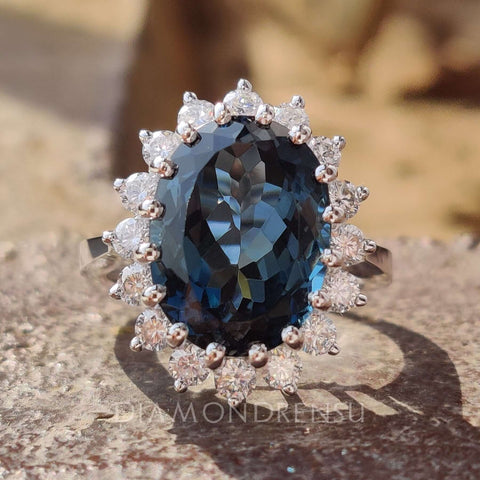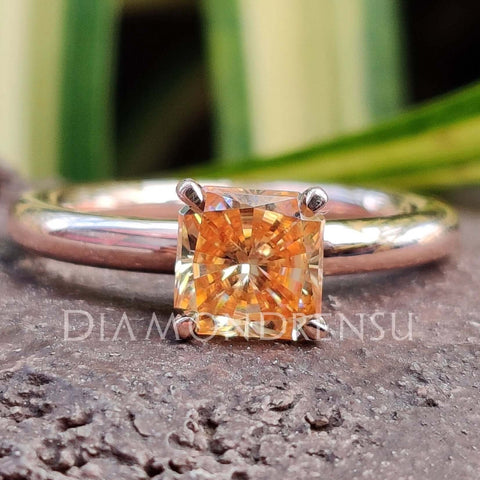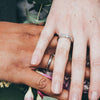
Female Right Ring Finger Meaning
Your right ring finger is more than just a location for a symbol of marriage or engagement.
It has been the subject of research and speculation for many years. In various cultures, the right ring finger holds significance and can be seen as a symbol of love and trust, balance, or even an indicator of personality traits. For instance, some believe that the length of your ring finger in relation to your index finger can reveal certain aspects about your character and predisposition.
One Step, One Promise, One Ring – Shop Brilliant Deals Now!
Recent studies have delved into the physiological differences between genders, observing that your right ring finger can sometimes help in gender estimation based on its comparison with the index finger length. Generally, men tend to have a longer ring finger in comparison to their index finger, while for women, these lengths are often similar or the index finger may be longer. This ratio, known as the 2D:4D ratio, has been linked to a wide array of other traits and dispositions.
Anatomical and Symbolic Significance

When you adorn your right ring finger with jewelry, you're participating in a practice rich with anatomical and symbolic heritage. The right ring finger has been tied to tradition and symbolism, particularly in engagement rings and their association with the heart.
Symbolism of the Right Ring Finger
Your right ring finger is often associated with creativity and beauty, which is why many artists prefer to wear rings on this finger. Culturally, it can signify professional status; for example, in some engineering professions, a ring on the pinky finger of the dominant hand, which can be the right hand for most people, symbolizes a degree in engineering.
Specifically, an engagement ring on the right ring finger may indicate that you are engaged or married, depending on the customs of your locality. In many cultures, however, the left hand has traditionally been the location for engagement rings, derived from the belief in the "vena amoris" or "vein of love" thought to run directly from the left ring finger to the heart.
Historical Context of Finger Rings
Rings have been tokens of power and status since ancient Egypt, where they were used as symbols in legal and business transactions.
The right hand, often considered the "action" hand, can signify your influence and authority in social or business contexts. Romans are credited with the custom of betrothal rings, an antecedent to modern engagement rings.
The tradition has evolved, but some cultures maintain the use of the right hand for betrothal or wedding rings, as opposed to the left, reflecting a fusion of ancient customs and contemporary practice.
Throughout history, the rings you choose to wear and their placement on your fingers tell a story of personal significance and cultural tradition.
Cultural and Regional Interpretations

When you consider the meaning of rings on the right ring finger, it is apparent that cultural and regional traditions play a significant role. The symbolism can vary greatly from one place to another, often intertwining with local customs, family heritage, and societal values.
Cultural Variations of Ring Placement
In many cultures, the placement of a ring on the right ring finger holds a special meaning. For example, in India, it is customary for women to wear their wedding rings on the right hand, denoting marital status and the joining of families. Conversely, in most Western countries, the left ring finger is traditionally reserved for this purpose, symbolizing love and commitment.
- Russia, Germany, and Austria:
- Wedding rings on right hand to represent the bond of marriage.
- Western Countries:
- Wedding rings traditionally worn on left ring finger.
The right ring finger can also reflect personal status or power in some societies. This is often seen in the use of family crests or coats of arms on signet rings, which can signify wealth and heritage. Such rings may be passed down through generations as part of family traditions.
Significance in Specific Cultures
Your understanding of the significance in specific cultures can give you deeper insights into their values and history. For instance, in India, the right hand is considered auspicious and the right ring finger reflects power and status, especially when adorned with precious stones.
- India:
- Right ring finger associated with astrology and cultural beliefs.
- Rings with specific stones may signify different aspects of life, such as status or wealth.
In some European cultures, the right ring finger can carry associations with professional stature or academic achievement. For example, in Germany and Austria, certain professionals may wear rings on this finger as a symbol of their qualifications and standing in their field.
Understanding these cultural and regional differences allows you to appreciate the diverse interpretations of wearing rings on the right ring finger around the world. Whether signifying marital status, family heritage, or personal accomplishment, the meaning behind this tradition is as varied as it is rich.
Types of Rings and Their Meanings
Rings worn on the fingers can signify various aspects of one's personal and social life. From denoting marital status to symbolizing personal accomplishments, each ring and the finger it adorns carry distinct meanings.
Signet and Class Rings

Signet rings, historically featuring a family crest or coat of arms, are often passed down through generations. These rings carry a sense of heritage and can represent personal or professional status. Notably, class rings signify academic achievement, typically engraved with the graduation year and worn to demonstrate alma mater pride.
Wedding and Engagement Rings
The connection between the left ring finger and marital status dates back to ancient beliefs about the "vena amoris," or vein of love. Wearing a wedding ring on this finger signifies marriage. An engagement ring, often a diamond ring, is also traditionally worn on the left ring finger to indicate an intention to marry. On the right hand, however, rings do not symbolize engagement or marriage in most Western cultures.
Fashion and Statement Rings

Rings on the right hand, specifically the right ring finger, often make a fashion statement rather than signify marital or relationship status. A diamond ring on this finger might reflect personal style or social status. Similarly, a pinky ring can signify professional influence or trend awareness, while a thumb ring often represents boldness or individuality. Middle finger rings are less traditional and can be seen as a statement of personal taste or a fashion-forward trend.
Social and Personal Connotations
The rings on your right ring finger are not only accessories but are imbued with social and personal significance. They act as markers of your societal position or personal beliefs, often reflecting your relationship status and self-identity.
Relationship and Marital Status Indicators
Wearing a ring on the right ring finger often speaks to your relationship status. While the left hand is traditionally associated with engagement rings and wedding bands, rings on the right hand could signify different statuses. For example, a promise ring might represent a pre-engagement commitment, whereas a chastity ring signals a decision to abstain from intimate relations until marriage. The choices range from subtle to statement pieces, each indicating a message about your personal commitments.
Self-Expression and Identity
Independence and self-confidence can be asserted through the choice of wearing a ring on your right hand. It may reflect your ambition or achievements, akin to wearing professional rings that denote a particular status or accomplishment in specific fields. More than anything, right hand ring meanings can be a powerful form of self-expression, broadcasting your personal style, values, or the confidence with which you navigate society. Whether through a simple band or a more elaborate design, the ring you choose is a symbol of your unique identity.
Materials and Adornments
| Material/Adornment | Description |
|---|---|
| Gold | Classic and timeless, available in various karats such as 14k, 18k, and 24k. |
| Silver | Lightweight and affordable, known for its sleek and modern appearance. |
| Platinum | Durable and resistant to tarnish, often used in high-end jewelry. |
| Diamonds | Hardest natural material, adds brilliance and sparkle to rings. |
| Gemstones | Colorful and diverse, ranging from sapphires and rubies to emeralds and more. |
| Pearls | Elegant and timeless, available in various shapes and colors. |
| Engravings | Personalized messages or designs added to the ring for sentimentality. |
| Filigree | Delicate and intricate metalwork, often used for vintage or ornate designs. |
| Wood | Natural and eco-friendly material, providing a unique and earthy aesthetic. |
| Ceramic | Lightweight and scratch-resistant, available in various colors. |
When considering rings on the female right ring finger, the choices of materials and adornments are not just about aesthetics. They often carry a deeper significance tied to cultural traditions, personal status, or symbolic meanings associated with different stones and metals.
Gemstones and Symbolic Representations
Gemstones are chosen not only for their beauty but also for the meanings they convey. For instance, diamonds are renowned for symbolizing everlasting love and indestructibility. Other gems, like blue topaz, are believed to enhance intuition and clear thinking. When set on the right ring finger, these stones often signal personal milestones or serve as talismans.
- Common gemstones and their symbolic meanings:
- Diamond: strength, love, and purity
- Blue Topaz: clarity, communication, and intuition
Metals and their Significance
The choice of metal for rings is equally important and can reflect one's social status or adhere to certain traditions. Gold, timelessly favored, exudes wealth and prestige, while silver offers a more subdued elegance. Contemporary choices like stainless steel or iron can signify resilience and practicality. Here's a brief overview of what certain metals can represent:
- Metals and their associated meanings:
- Gold: prosperity, warmth, and tradition
- Silver: calmness, balance, and sophistication
- Iron: strength, determination, and simplicity
- Stainless Steel: modernity, durability, and resilience
Ring Placement and Social Implications

In understanding ring placement, it's key to consider cultural contexts and the traditional meanings associated with different fingers.
Right Hand vs. Left Hand
Wearing a ring on your right hand often signifies professional status or education. In some cultures, a ring on the right ring finger could symbolize graduation or professional achievement. Conversely, the left hand is typically linked to marital status or personal commitment, with a ring on the left ring finger thought to be connected to the heart through the vena amoris.
- Right hand: Signals achievement, profession.
- Left hand: Traditionally linked to marriage, commitment.
Finger-Specific Meanings
Each finger carries specific implications when adorned with a ring:
- Thumb: Wearing a ring on your thumb may indicate ambition or wealth. It's less common and can stand out as a statement of power.
- Index finger: A ring on either right or left index finger often suggests a desire for leadership or displays a sense of ambition. Historically, it could also represent a family crest.
- Middle finger: Stability and balance are characteristics associated with rings on the middle finger. It's a neutral location, not typically linked to societal implications.
- Right ring finger: Aside from professional symbols, it can also represent creativity and balance in one's life.
- Left ring finger: This is usually reserved for wedding rings, symbolizing love and commitment.
- Pinky finger: A ring on the pinky finger, especially the left pinky, can signify graduation from a degree in engineering or denote a profession in some cultures. Rings on the right pinky are sometimes associated with professional status.
- Little finger: Often represents confidence in communication and is sometimes linked to professions in the arts or communication.
Each placement sends a unique message about your personal qualities, aspirations, or your social and professional status.
Changes and Trends in Ring Fashion

Fashion is an ever-evolving industry, and the trends in ring fashion are no exception. Fashion statement rings have seen various transformations over the years, with each shift reflecting broader societal changes and personal expression. Rings, specifically for the female right ring finger, often symbolize assertiveness and independence.
You may have observed the trend towards cocktail rings, which surged in popularity during the 1920s and have recently made a comeback. These rings are characterized by their oversized, dramatic appearance and are often worn as a bold statement piece. They're not just for special occasions anymore; you can incorporate them into your everyday wardrobe to add a touch of glamour.
Eternity rings originally symbolized everlasting love and were typically worn on the left hand. However, their appeal has broadened. Today, you might wear one on your right ring finger as a symbol of self-love or achievement. Eternity rings now come in various designs, with gemstones encircling the entire band or just a certain segment for a modern twist.
As trends continue to change, you may see rings designed with mixed metals, unconventional shapes, and textured finishes gaining popularity. Whether through personal choice or cultural shifts, your selection of a ring for the right ring finger is a form of self-expression that keeps in step with the changing face of fashion.
Frequently Asked Questions
Rings on different fingers for women often have varied implications, incorporating social status, personal statements, and cultural traditions. The right hand, in particular, carries its own symbolism.
What is the significance of wearing a ring on the right ring finger for women?
For many women, wearing a ring on the right ring finger might signify professional achievement or personal status. In some cultures, it could also represent marital status or engagement akin to the traditional left-hand practice.
Does sporting a ring on the right middle finger carry a specific meaning for women?
A ring on the right middle finger doesn't have a standard meaning but is sometimes used to signify a person's individual style or to make a fashion statement. In some interpretations, it can also symbolize balance and responsibility.
Can wearing a ring on the index finger of a woman convey a particular message?
When you wear a ring on your right index finger, it may be interpreted as a sign of leadership, ambition, or a desire for assertiveness since this finger is typically associated with authority.
Is there a symbolic implication when a woman wears a ring on her right pinky finger?
A ring on the right pinky finger can often indicate professional status, especially in professions that have specific rings, such as engineering. It may also be a sign of a woman's marital status to signify widowhood in some European cultures.
Is it culturally acceptable for a single woman to wear a ring on her right hand?
In many Western societies, it is culturally acceptable for single women to wear rings on their right hand. This practice has no specific implication regarding their relationship status and is often seen as a fashion choice or a statement of independence.
How do interpretations of ring placements differ for women's left and right hands?
The left hand is traditionally associated with wedding bands and engagement rings, signifying a commitment to another person. Rings on the right hand are generally seen as a reflection of personal identity or social and professional achievements.
Checkout some of our top collections:
Comments
Leave a comment
Please note, comments must be approved before they are published.














FELICIA
April 03, 2025